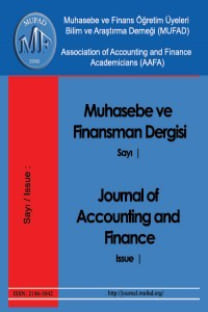En Yüksek Piyasa Değerine Sahip On Kripto Paranın Birbirleriyle Etkileşimi
Çalışmada gün geçtikçe popülerliği ve buna bağlı olarak toplam piyasa değerleri ve işlem hacimleri artan, çok sayıda ve çok çeşitli piyasalarda işlem gören kripto paraların fiyatlarının birbiri üzerindeki etkisi araştırılmıştır. Çalışmada, Bitcoin, Ethereum, Ripple, Bitcoin Cash, Cardano, Litecoin, NEM, NEO, Stellar ve IOTA kripto paralarının seçiminde toplam piyasa değerleri dikkate alınmıştır ve en yüksek toplam piyasa değerine sahip 10 kripto para analize dahil edilmiştir. 15 Aralık 2017 ve 17 Ocak 2018 tarihleri arasında çalışmaya konu olan kripto paraların günlük fiyat hareketleri arasındaki ilişkiyi incelemek için serilere Johansen Eşbütünleşme Testi ve Granger Nedensellik Testi uygulanmıştır. Çalışmanın sonucunda, Cardano’nun NEO’nun Granger nedeni olduğu, Bitcoin’in Bitcoin Cash’in Granger nedeni olduğu, Litecoin’in Bitcoin Cash’in Granger nedeni olduğu, NEM’in Bitcoin Cash’in Granger nedeni olduğu, Ripple’ın Bitcoin’in Granger nedeni olduğu, NEO ve Ethereum’un birbirinin Granger nedeni olduğu, NEO ve Litecoin’in birbirinin Granger nedeni olduğu ve NEM’in Stellar’ın Granger nedeni olduğu tespit edilerek, bu değişkenlerin fiyat hareketlerinin kısa dönemde birbirini etkilediği ortaya konmuştur.
Anahtar Kelimeler:
Blockchain Teknolojisi, Kripto Paralar, Johansen Eşbütünleşme Testi
___
- Atik, Murat – Köse, Yaşar – Yılmaz, Bülent – Sağlam, Fatih (2015). “Kripto Para: Bitcoin ve Döviz Kurları Üzerine Etkileri”, Bartın Üniversitesi İktisadi ve İdari Bilimler Fakültesi Dergisi, 6(11), ss. 247-261.
- Balcılar, Mehmet - Bouri, Elie - Gupta, Rangan - Roubaud, David (2017). “Can Volume Predict Bitcoin Returns and Volatility ? A Quantiles-Based Approach”, Economic Modelling, 64, pp. 74-81.
- Bridgers, Adam (2017). “Will Workplaces be Going off the Rails 0n the Blockchain?”, Journal off Internet Law, 20(11), pp. 3-6.
- Ciaian, Pavel – Rajcaniova, Miroslava – Kancs, d’Artis (2018). “Virtual Relationships: Short and Long Run Evidence from Bitcoin and Altcoin Markets”, Journal of International Financial Markets, Institutions and Money, 52, pp. 173-195.
- Demirci, N. Savaş (2017). “İmalat Sanayi Sektöründe Üretim ve Banka Kredileri İlişkisi: Türkiye İçin Eşbütünleşme ve Nedensellik Analizi”, Dokuz Eylül Üniversitesi Sosyal Bilimler Enstitüsü Dergisi, 19(1), ss.35-61.
- Dyhrberg, Anne Haubo (2016). “Bitcoin, Gold and the Dollar, A GARCH Volatility Analysis”, Finance Research Letters, 16(2016), pp. 85-92.
- Dwyer, Gerald P. (2015). “The Economics of Bitcoin and Similar Private Digital Currencies”, Journal of Financial Stability, 17(2015), pp. 81-91.
- Granger, Clive W. J. (1969). “Investigating Causal Relations by Econometric Models and Cross-Spectral Methods”, Econometrica: Journal of the Econometric Society, 37(3), pp. 424-438.
- Granger, C.W.J.- Newbold, P. (1974). “Spurious regression in econometrics”, Journal of Econometrics, 2, pp. 111-120.
- Iansiti, Marco - Lakhani, Karim R. (2017). “The Truth About Blockchain”, Harvard Business Review, 95(1), pp. 118-127. https://tr.investing.com/crypto/currencies, Erişim Tarihi: 17.1.2018
- Europen Central Bank, (2012). “Virtual Currency Schemes” (https://www. ecb. europa. eu/pub/pdf/other/virtualcurrencyschemes201210en.pdf, Erişim tarihi: 02.12.2017)
- Europen Central Bank, (2012), Virtual Currency Schemes, (https://www. ecb.europa.eu/pub/pdf/other/virtualcurrencyschemes201210en.pdf, Erişim tarihi: 02. 12.2017.
- Isa, M. (2017). Speculative Instrument or Game-Changer?. Finweek, pp.18-18.
- Johansen, Soren (1988). “Statistical Analysis of Cointegration Vectors”, Journal of Economic Dynamics and Control, 12(2-3), pp. 231-254.
- Katsiampa, Paraskevi (2017). “Volatility Estimation for Bitcoin: A Comprasion of GARCH Models”, Economics Letters, 158, pp. 3-6.
- Kristoufek, Ladislav (2014). “What Are the Main Drivers of the Bitcoin Price? Evidence from Wavelet Coherence Analysis”, Cornell University Library, http://arxiv.org/abs/ 14.06.0268, Erişim tarihi: 10.1.2018.
- Li, Xin – Wang, Chong Alex (2017). “The Technology and Economic Determinants of Cryptocurrencies Exchange Rates: The case of Bitcoin”, Decision Support Systems, 95, pp. 49-60. www.kriptopara.org, Erişim tarihi: 01.12.2017.
- Nakamoto, Satoshi (2009). “Bitcoin: A Peer to Peer Electronic Cash System”, https://bitcoin.org/bitcoin.pdf, Erişim tarihi: 15.12.2017
- Narayanan, Arvind - Miller, Andrew (2017). “Research for Practice: Cryptocurrincies, Blockchains and Smart Contracts: Hardware for Deep Learning”, Communications of the ACM, 60(5), pp. 48-51.
- Sahoo, Pradipta Kumar (2017). “Bitcoin as Digital Money: Its Growth and Future Sustainability”, Theoretical and Applied Economics, 24(4-613), pp. 53-64.
- Scott, Brett - Loonam, John - Kumar, Vikas (2017). “Exploring the Rising Blockchain Technology: Towards Distributed Collaborative Organizations”, Strategic Change, 26(5), pp. 423-428.
- Sharma, Suksham (2017). “Digital Mints: Know the Factory”, PC Quest, 30(7), pp. 54-57.
- Singh, Kavid (2015). “The New Wild west: Preventing Money Laundering in the Bitcoin Network”, Northwestern Journal of Technology and Intellectual Property, 13(1), pp. 38-63.
- Sontakke, Kaustubh Arvind - Ghaisas, Aishwarya (2017). “Crypto Currencies: A Developing Asset Class”, Internatioanal Journal of Business Insight and transformation, 10(2), pp. 10-17. Wandhöfer, Ruth (2017). “The future of digital retail payments in Europe: A Place for Digital Cash”, Journal of Payments Strategy&Systems, 11(3), pp. 248-258.
- ISSN: 2146-3042
- Yayın Aralığı: Yılda 4 Sayı
- Başlangıç: 2005
- Yayıncı: Muhasebe ve Finansman Öğretim Üyeleri Derneği (MUFAD)
Sayıdaki Diğer Makaleler
Aylin POROY ARSOY, Yasemin ERTAN, Tuba BORA KILINÇARSLAN
Denetçi Seçimine Etki Eden Faktörlerin Analizi: Borsa İstanbul’dan Bulgular
Tahakkuk Kalitesi ve Kârın Süreğenliği Arasındaki İlişkinin İncelenmesi: BIST 100 Örneği
En Yüksek Piyasa Değerine Sahip On Kripto Paranın Birbirleriyle Etkileşimi
Gökben ADANA KARAAĞAÇ, Serpil ALTINIRMAK
Türkiye’deki Emeklilik Şirketlerinin Etkinlik Analizi
Neilan SOYLU, Hasan UYGURTÜRK, Turhan KORKMAZ
